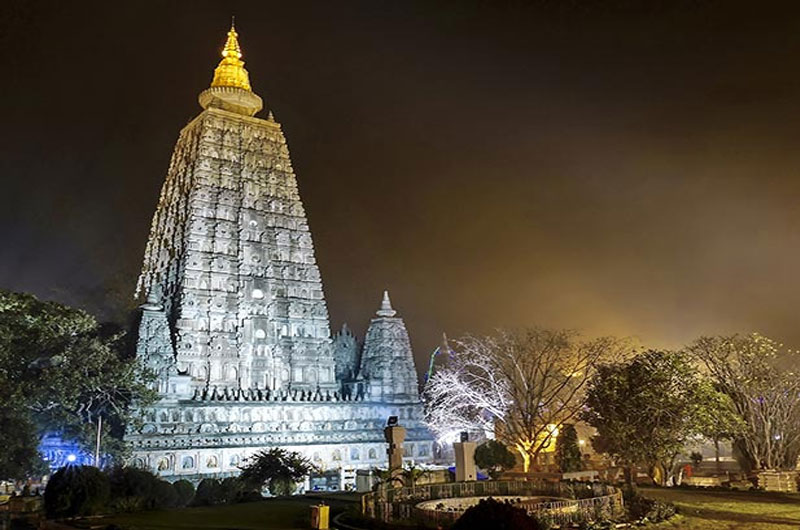
Mahabodhi Temple: The Sacred Site of Enlightenment in Bihar
The Mahabodhi Temple, situated in Bodh Gaya, Bihar, stands as one of the most significant and revered Buddhist pilgrimage sites in the world. Recognized as a UNESCO World Heritage Site, this ancient temple marks the location where Siddhartha Gautama, who later became the Buddha, attained enlightenment under the Bodhi tree. This sacred site draws pilgrims, historians, and travelers from across the globe who come to witness the spiritual aura and historical grandeur of one of Buddhism’s most important locations. This guide provides an in-depth exploration of the Mahabodhi Temple, covering its history, significance, tourist attractions, best times to visit, and practical information for travelers.
History of Mahabodhi Temple
Ancient Origins
- Historical Significance: The Mahabodhi Temple is intrinsically linked to the life of Siddhartha Gautama, the Buddha. It is believed that he meditated under the Bodhi tree in Bodh Gaya and attained enlightenment around the 5th century BCE.
- Early Structures: The original temple was built during the reign of Emperor Ashoka in the 3rd century BCE. Ashoka, a devout Buddhist, constructed the temple to commemorate the place of Buddha’s enlightenment.
Medieval Period
- Rediscovery and Reconstruction: The temple underwent several phases of reconstruction and renovation over the centuries. In the 7th century CE, the famous Chinese traveler Xuanzang documented the temple and its significance, which led to further restoration efforts.
- Destruction and Restoration: The temple faced periods of neglect and destruction, particularly during the medieval Islamic invasions. However, it was restored in the 19th century under the British colonial administration, which helped preserve its historical integrity.
Tourism Specialty and Locality
Unique Attractions
- Bodhi Tree: The Mahabodhi Temple is home to the descendant of the original Bodhi tree under which the Buddha attained enlightenment. This sacred tree is central to the temple complex and is a focal point for pilgrims and visitors.
- Temple Architecture: The temple is a prime example of early Buddhist architecture, characterized by its massive pyramidal spire, intricate carvings, and elegant sculptures. The temple’s structure has influenced Buddhist architecture throughout Asia.
- Monastic Complex: The temple complex includes several monasteries and stupas, providing insight into the Buddhist monastic tradition and offering a serene environment for meditation and reflection.
Locality
- Location: The Mahabodhi Temple is located in Bodh Gaya, a town in the Gaya district of Bihar, India. It is approximately 110 kilometers from Patna, the state capital of Bihar.
- Accessibility: Bodh Gaya is well-connected by road and rail. The nearest airport is in Gaya, with regular flights from major Indian cities. Patna’s airport, around 110 kilometers away, also serves as an access point.
Best Time to Visit
Ideal Seasons
- Winter (October to March): The best time to visit the Mahabodhi Temple is during the winter months when the weather is cool and pleasant, making it ideal for sightseeing and exploring the temple complex. Daytime temperatures are comfortable, and the humidity is lower.
- Monsoon (June to September): While the monsoon season brings lush greenery, it also involves heavy rainfall, which can sometimes cause travel disruptions and inconvenience.
Peak Seasons
- Buddha Jayanti (April-May): The celebration of Buddha’s birth, enlightenment, and death is a significant time for visitors, with various religious ceremonies and events taking place. It is a vibrant time to experience the spiritual atmosphere of the temple.
- Vesak Festival: This is another major Buddhist festival celebrated around April or May, attracting a large number of pilgrims and tourists.
Nearby Tourist Spots
Bodhi Tree
- Significance: The Bodhi Tree, located within the temple complex, is a living symbol of the Buddha’s enlightenment. Pilgrims often come to meditate and offer prayers at this sacred tree.
- Location: Inside the Mahabodhi Temple complex.
Mahabodhi Temple Archaeological Site
- Significance: This site features ancient ruins and remains from various periods of the temple’s history, offering insights into its historical evolution and architectural changes.
- Location: Adjacent to the Mahabodhi Temple complex.
Great Buddha Statue
- Significance: The Great Buddha Statue is a 80-foot tall statue located in Bodh Gaya, representing the Buddha in a meditative posture. It is a significant landmark and provides a striking visual element to the town.
- Location: About 1.5 kilometers from the Mahabodhi Temple.
Tibetan Monastery
- Significance: This monastery is known for its Tibetan Buddhist practices and serves as a center for learning and meditation. It offers a tranquil environment and beautiful traditional Tibetan architecture.
- Location: Close to the Mahabodhi Temple.
Sujata Stupa
- Significance: The Sujata Stupa marks the location where Sujata, a village woman, offered rice pudding to the Buddha before his enlightenment. The stupa is an important pilgrimage site and historical monument.
- Location: Approximately 8 kilometers from Bodh Gaya.
Nearby Restaurants
The Royal Residency Restaurant
- Cuisine: Offers a range of Indian, Chinese, and continental dishes. Known for its comfortable ambiance and diverse menu.
- Location: Near the Mahabodhi Temple.
Buddha Hotel and Restaurant
- Cuisine: Specializes in vegetarian dishes, including traditional Indian and Tibetan cuisine. Popular among tourists and pilgrims.
- Location: In Bodh Gaya, close to the temple.
The Park Restaurant
- Cuisine: Serves a mix of Indian and international cuisines with an emphasis on fresh ingredients and quality service.
- Location: Bodh Gaya, not far from the Mahabodhi Temple.
Maitreya Restaurant
- Cuisine: Known for its authentic Tibetan food and friendly atmosphere. Offers a variety of vegetarian and non-vegetarian dishes.
- Location: Bodh Gaya.
Nearby Hotels
Hotel Bodh Gaya
- Features: Provides comfortable accommodation with modern amenities including air-conditioned rooms, a restaurant, and easy access to the temple.
- Location: Close to the Mahabodhi Temple.
Hotel Siddhartha
- Features: Offers a range of facilities including spacious rooms, a multi-cuisine restaurant, and proximity to major attractions.
- Location: Near the Mahabodhi Temple, Bodh Gaya.
Hotel Lumbini International
- Features: Features well-furnished rooms, a restaurant, and services tailored for both tourists and pilgrims.
- Location: Bodh Gaya, within easy reach of the temple.
Hotel Tathagata
- Features: A budget-friendly option with basic amenities, including clean rooms and a convenient location near the Mahabodhi Temple.
- Location: Bodh Gaya.
Pilgrimage Experience
Visiting the Temple
- Entry Requirements: The temple is open to all visitors, and there is no entry fee. However, it is advisable to dress modestly and respect the sacred nature of the site.
- Rituals and Offerings: Pilgrims and visitors can participate in various rituals, including meditation, circumambulation of the temple, and offering prayers at the Bodhi Tree.
- Guided Tours: Local guides are available to provide detailed insights into the temple’s history, architecture, and significance.
Exploring the Surroundings
- Meditation and Reflection: The temple complex offers a serene environment for meditation and contemplation. Many visitors take time to sit in quiet reflection or participate in guided meditation sessions.
- Shopping and Souvenirs: Nearby markets offer a range of souvenirs, including Buddhist artifacts, prayer flags, and traditional crafts.
Conclusion
The Mahabodhi Temple in Bodh Gaya is not only a profound spiritual site but also a symbol of enlightenment and peace. Its historical and architectural grandeur, combined with its significance in Buddhist tradition, makes it a must-visit destination for pilgrims and tourists alike. By exploring the temple’s rich history, enjoying the local attractions, and staying in comfortable accommodations, visitors can fully appreciate the spiritual and cultural essence of this sacred site. Whether you are seeking spiritual growth, historical knowledge, or simply a serene retreat, the Mahabodhi Temple offers a profound and enriching experience.
